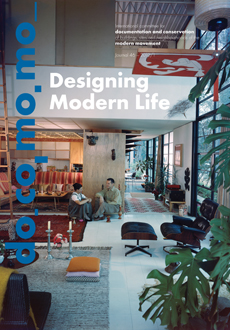PUBLICATIONS
DOCOMOMO JOURNAL 46: Designing Modern Life

Author: Ana Tostões, Bárbara Coutinho, Jurjen Creman, Otakar Mácêl, Monika Wagner, ed.al.
Publisher: DOCOMOMO International (2012)
Dimensions (length x width x height): 21 cm × 1 cm × 30 cm
Pages: 100
Language: English
Go to DOCOMOMO International online shop
DESCRIPTION:
Docomomo Journal 46 (Summer 2012)
Editorial
Designing Modern Life by Ana Tostões
Essays:
Why Preserve Modern Now? by Bárbara Coutinho
Visions on Furniture by Jurjen Creman
Modern Architecture and Modern Furniture by Otakar Mácêl
Mies van der Rohe’s Tugendhat House – Weightless Living by Monika Wagner
Investigation and Production of Furniture for Villa Tugendhat 2009–2012 by Miroslav Ambroz
Modernism in Finnish Furniture Design and Production by Pekka Korvenmaa
Artek and Alvar Aalto by Mia Hipeli
Metsäpaviljonski, Form Follows Wood by Cristian Suau
Charles and Ray Eames: Modern Living in a Postwar Era by Kyle Normandin
Clara Porset. A Modern Designer for Mexico by Louise Noelle
Gaston Eysselinck and his Masterpiece. The Post Office Building in Ostend (1945-1953) by Marc Dubois
Dieter Rams. Ethics and Modern Philosophy: What Legacy Today? by Klaus Klemp
Documentation Issues:
ODAM and the Construction of a Modern Spirit by Edite Rosa
Svetlovodsk: Realized Urban Utopia of the USSR by Vladislav Tyminski and Anna Kamyshan
docomomo News and Information / Tribute
Book Reviews
Appendix
Editorial
Designing Modern Life by Ana Tostões
The argument of this docomomo Journal stands for interior design identified as a key conservation issue for modern living.
docomomo acknowledges the major relevance of reflecting on the Modern Movement heritage, focusing on one of the most fragile conservation issues: modern interior space namely on modern furniture and product design questions.
The aim is to contribute for the discussion that relates modern heritage and interior space, common daily life and musealization of Modern Interior Spaces, gathered underneath a global strategy, to better understand and preserve these delicate monuments. In fact, the interior space with all devices and furniture pieces is frequently not appreciated as an essential matter in safeguard interventions. That’s why 2012 docomomo Journals are devoted to interior design and furniture, discussing preservation strategies and critical reflexions.
Ranging from restoration process research and know-how, new modern materials and techniques are discussed facing up to new conservation process and innovative rehabilitation solutions, as well. One knows that Modern spatiality must require furniture conceived under a unitary design concept, which implies today to identify every detail with the aim of a reconstruction process, where research on documentation is one of the success keys.
This year of 2012, when docomomo major Conference is hosted at the Espoo Cultural Center, the stimulus of this city center settlement in connection to Otaniemi University Campus is the starting point that justifies going deeper in the relation that connects form and function, esthetics and ethics. In fact, as Gropius stated, the “design from the cup of coffee to the urban plan” ability is the motto challenge for the 12th docomomo International Conference simultaneously with Helsinki being the World Design Capital 2012 dealing with all disciplinary aspects.
Finally, this issue wishes to pay tribute to the Finnish culture and its original contribution to Design. Indeed, through the conception of organic forms and the use of natural materials, a different path has been explored answering to sensorial and tactile comfort. Following the global design idea, this theme is the result of a challenge which is related to the Finnish approach to Modern Movement architecture, namely to an organic character that privileges comfort and economy, beauty and utility, simplicity and synthesis; improving regional roots in order to fulfill the sense of the place.
I wish to thank Bárbara Coutinho who acted as guest editor of this “Designing Modern Life” Dossier. Due to her knowledge and know-how acquired within a transversal framework as an art historian, researcher, curator and MUDE director, together with the knowledge shared by a range of authors, in connection with pioneer practical investigation on the subject carried out by restorers and researchers, it is possible to extend this debate over the reflection on the creation itself, the tools created by Modern Movement architects and designers to answer to efficiency and economy, improving comfort and beauty in daily life.
Ana Tostões
Chair of docomomo International



